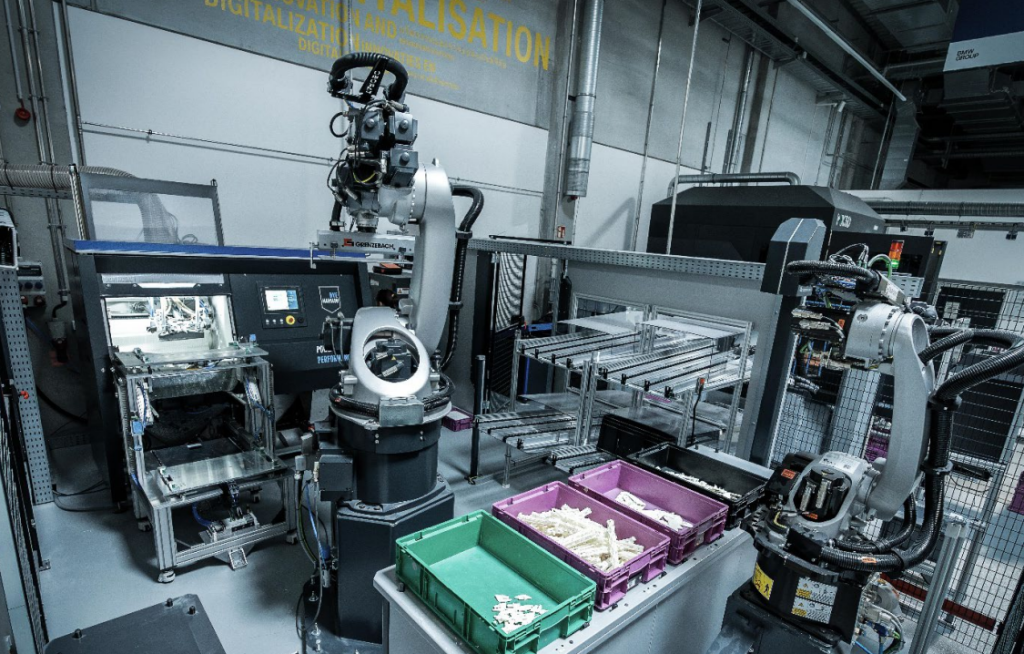The POLYLINE project has successfully implemented an automated additive manufacturing (AM) production line for polymer parts on a large scale.
The consortium partners, including BMW, DyeMansion, EOS, and Grenzebach, have completed the project as planned over a three-year duration. Taking place at BMW’s Additive Manufacturing Campus, this project marks a significant stride in enabling high-throughput 3D printing for serial production, with BMW assuming coordination of the consortium partners.
“The POLYLINE automated process chain fits into the next generation printers and our standard production requirements, is a system-agnostic solution due to their standardized interfaces. Which is crucial for scaling up additive manufacturing,” said Dr. Blanka Szost-Ouk, Head of additive manufacturing, Predevelopment & Planning at BMW Group.
Read all the 3D Printing Industry coverage from Formnext 2023.

POLYLINE project paves the way for automotive 3D printing
The POLYLINE project united 15 industrial and research partners in Germany with the goal of creating a next-generation digitalized production line for plastic parts in the automotive industry. Funded by the German Federal Ministry of Education and Research, the project was allocated €10.7 million. With the successful conclusion of the project, the partners involved have achieved their objectives and made significant progress in advancing additive manufacturing in industrial applications.
EOS played a key role in the printing process with its EOS P 500, which enhanced industrial additive manufacturing. This machine offers full automation and integration, allowing for adaptability according to specific use cases and ensuring reliability and consistency. Grenzebach, known for its expertise in the automation of industrial processes, contributed by networking manufacturing processes safely and efficiently. This includes the Exchange P500/4 solution, automating frame replacement and cooling in buffer stations within the 3D printer. An automated guided vehicle (AGV) then transports the frame, while a robotic cell manages additional processing and sorting. Grenzebach developed hardware and software interfaces for industrial use across all process stations.
DyeMansion was responsible for post-processing steps, ensuring a consistent look and feel for the final applications. Of particular note is the Powershot DUAL Performance, which meets the demands for physical automation. This system can operate batch after batch continuously, eliminating the need for a constant human operator presence.
“The successful POLYLINE project shows that an end-to-end automated factory is possible with 3D printing – and this is just the beginning,” said Phillip Kramer, CTO and Co-Founder of DyeMansion.
Advancements in polymer 3D printing
Starting on November 16, 3D printing company Mosaic Manufacturing is shipping its Array polymer 3D printers, with Element and Element HT 3D printers. Array, designed for industrial use, includes automation features like material changeover, AI monitoring, and software automation. Each Array unit comprises four Element or Element HT 3D printers, starting at $79,999 USD. The system enables autonomous 3D printing of polymer parts, reducing lead times and bolstering manufacturing capabilities. Additionally, the company’s Canvas Edu platform streamlines 3D printing workflows for educational institutions.
Last year, 3D4Makers, AON3D, Hexagon, and Zymergen conducted an experiment on the 3D printing polymer, dubbed Z2 Polyimide. The material displayed superior attributes, with a highly isotropic and strong AM polymer part that endured a load of 432 kg before failure. Hexagon’s Digimat AM software predicted the part’s performance, allowing engineers to reduce lead times and simulate end-part behavior. Z2 Polyimide exhibited improved strength and isotropy compared to ULTEM 9085, potentially positioning it as an alternative. This experiment highlights the rapid advancements in material breakthroughs and open material industrial 3D printers, outpacing closed systems.
Voting has now started for the 3D Printing Industry Awards 2023. Cast your vote now!
What does the future of 3D printing for the next ten years hold?
What engineering challenges will need to be tackled in the additive manufacturing sector in the coming decade?
To stay up to date with the latest 3D printing news, don’t forget to subscribe to the 3D Printing Industry newsletter or follow us on Twitter, or like our page on Facebook.
While you’re here, why not subscribe to our Youtube channel? Featuring discussion, debriefs, video shorts, and webinar replays.
Are you looking for a job in the additive manufacturing industry? Visit 3D Printing Jobs for a selection of roles in the industry.
Featured image shows A section of the POLYLINE project with automated systems of Grenzebach, DyeMansion and EOS, located at the Additive Manufacturing Campus of BMW. Photo via DyeMansion.



